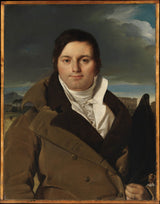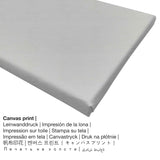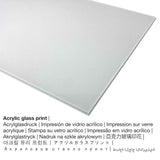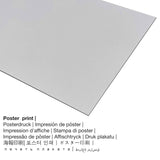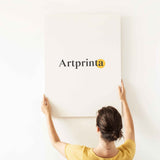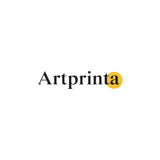Jean Auguste Dominique Ingres, 1810 - Joseph-Antoine Moltedo (amụrụ 1775) - mbipụta nka mara mma.
Ụtụ gụnyere. Mbupu gbakọrọ na ndenye ọpụpụ.
Họrọ ihe ngwaahịa gị
Anyị na-enye ụdị nha na ihe dị iche iche maka ngwaahịa ọ bụla. Nha na ihe ndị a bụ nhọrọ anyị na-enye gị maka nkeonwe:
- Mbipụta aluminom (aluminium dibbond): Aluminium Dibond prints are prints on metal with an impressive depth. The Aluminium Dibond Print is the excellent introduction to fine reproductions produced with aluminum. The white & bright components of the original work of art shimmer with a silky gloss but without glow. Colors are luminous, details are crisp, and you can really perceive the matte appearance of the print. The direct print on aluminium is one of the most demanded entry-level products and is an extremely modern way to display fine art reproductions, since it draws focus on the replica of the artwork.
- Mbipụta akwụkwọ mmado (akwa akwa akwa): The poster print is a printed canvas paper with a fine surface texture. Please keep in mind, that depending on the absolute size of the poster we add a white margin 2-6cm around the print in order to facilitate the framing with your custom frame.
- Mbipụta kwaaji: The printed canvas mounted on a wooden frame. A canvas has a distinctive impression of three-dimensionality. A canvas makes a cosy and pleasant effect. The advantage of canvas prints is that they are relatively low in weight, which means that it is easy and straightforward to hang your Canvas print without any wall-mounts. That is why, a canvas print is suitable for any type of wall.
- Bipụta na iko acrylic na-egbuke egbuke (nke nwere ezigbo mkpuchi iko): The print on acrylic glass, often labelled as a plexiglass print, will change an original into great wall décor and forms a distinct alternative to aluminium and canvas fine art replicas. The great advantage of an acrylic glass fine art print is that contrasts as well as smaller painting details will be recognizeable with the help of the precise tonal gradation in the print.
Disclaimer: We try what we can to describe the products in as much detail as possible and to display them visually on the various product detail pages. Although, the pigments of the print products and the printing may differ to a certain extent from the image on your device's monitor. Depending on the settings of your screen and the condition of the surface, color pigments might not be printed one hundret percent realistically. Considering that our art reproductions are processed and printed by hand, there may also be minor differences in the exact position and the size of the motif.
Ozi mgbakwunye sitere n'aka Ụlọ ihe ngosi nka nke Obodo ukwu (© - site n'aka The Metropolitan Museum of Art - Museumlọ ihe ngosi nka nke Obodo)
Corsican by birth, Moltedo was an enterprising businessman and inventor, agent to the French clergy at the Vatican, and director of the Roman post office from 1803 until 1814. Painted during one of the most productive periods of Ingres’s nascent career, this refined portrait belongs to a series of commissions he received from French officials in Napoleonic Rome. They are distinguished by the inclusion of Roman views as backdrops—in this case the Appian Way and the Colosseum—as well as by stormy gray skies, a Romantic conceit that serves as a foil to the calm and secure expressions of the men portrayed.
Nke a gafee 210 year-old artpiece was painted by Jean Auguste Dominique Ingres. The beyond 210 okike izizi nke afọ nwere nha: 29 5/8 x 22 7/8 na (75,2 x 58,1 cm). Oil on canvas was applied by the French artist as the technique for the painting. The piece of art forms part of the digital collection of The Metropolitan Museum of Art, which is one of the world's largest and finest art museums, which includes more than two million works of art spanning five thousand years of world culture, from prehistory to the present and from every part of the globe.. This ngalaba ọha artpiece is provided with courtesy of The Metropolitan Museum of Art, New York, H. O. Havemeyer Collection, Bequest of Mrs. H. O. Havemeyer, 1929. In addition, the work of art has the creditline: H. O. Havemeyer Collection, Bequest of Mrs. H. O. Havemeyer, 1929. Furthermore, alignment of the digital reproduction is in Eserese format na nwere akụkụ ruru nke 3: 4, nke pụtara na ogologo bụ 25% mkpụmkpụ karịa obosara.
Nkọwa gbasara ọrụ nka mbụ
| Aha eserese: | "Joseph-Antoine Moltedo (born 1775)" |
| Nhazi nke ọrụ nka: | sere |
| Okwu nche anwụ: | nkà nke oge a |
| oge: | 19th narị afọ |
| Afọ nka: | 1810 |
| Afọ nka: | ihe karịrị afọ 210 |
| Agba na: | mmanụ na kwaaji |
| Nha nke ihe nka izizi: | 29 5/8 x 22 7/8 na (75,2 x 58,1 cm) |
| Egosiputara na: | Museumlọ ihe ngosi nka nke Obodo |
| Ebe ngosi nka: | New York City, New York, Njikota Obodo Amerika |
| URL webụ: | www.metmuseum.org |
| Ụdị ikike nka: | ngalaba ọha |
| Site n'aka: | Ụlọ ihe ngosi nka nke Metropolitan, New York, HO Havemeyer mkpokọta, Arịrịọ nke Oriakụ HO Havemeyer, 1929 |
| kreditline ọrụ nka: | Mkpokọta HO Havemeyer, Arịrịọ nke Oriakụ HO Havemeyer, 1929 |
Banyere ihe
| Bipụta ụdị ngwaahịa: | ọmarịcha nka |
| Usoro mmeputakwa: | dijitalụ mmeputakwa |
| Usoro mmepụta: | Mbipụta UV ozugbo (mbipụta dijitalụ) |
| Production: | arụpụtara na Germany |
| Stockdị ngwaahịa: | a na-achọ |
| Eji ngwaahịa a chọrọ: | ihe ndozi mgbidi, mgbidi gallery |
| Nhazi nka nka: | nhazi ihe osise |
| Ụdị anya: | 3: 4 |
| Ntụgharị nkọwa akụkụ: | ogologo bụ 25% mkpụmkpụ karịa obosara |
| Akụrụngwa dị: | Mbipụta kwaaji, mbipụta ọla (aluminium dibond), mbipụta enyo acrylic (nwere ezigbo mkpuchi iko), mbipụta akwụkwọ mmado (akwụkwọ kwaaji) |
| Nha n'arọwa n'elu ihe ndọtị (mbipụta akwa akwa): | 30x40cm - 12x16", 60x80cm - 24x31", 90x120cm - 35x47", 120x160cm - 47x63" |
| Mpempe iko acrylic (nwere ezigbo mkpuchi iko) nha: | 30x40cm - 12x16", 60x80cm - 24x31", 90x120cm - 35x47" |
| Mpempe akwụkwọ mmado (akwụkwọ kwaaji) nha dị iche iche: | 30x40cm - 12x16", 60x80cm - 24x31", 90x120cm - 35x47" |
| Mpempe akwụkwọ Dibony (ihe alumnium) nha: | 30x40cm - 12x16", 60x80cm - 24x31", 90x120cm - 35x47" |
| Igwe onyonyo: | adịghị |
Nkọwa onye nka
| Aha onye nka: | Jean Auguste Dominique Ingres |
| Gender: | nwoke |
| Obodo onye nka: | French |
| Ọrụ: | onye na-ese ihe |
| Mba onye si: | France |
| nhazi ọkwa: | omenkà nke oge a |
| Nwụrụ na afọ nke: | 87 afọ |
| Amụrụ n'afọ: | 1780 |
| Ebe amụrụ onye: | Montauban |
| Afọ nwụrụ: | 1867 |
| Nwụrụ na (ebe): | Paris |
© echekwabara ikike nwebiisinka, www.artprinta.com (Artprinta)

